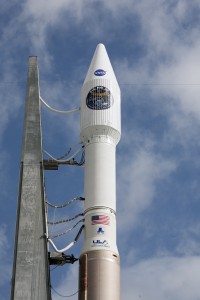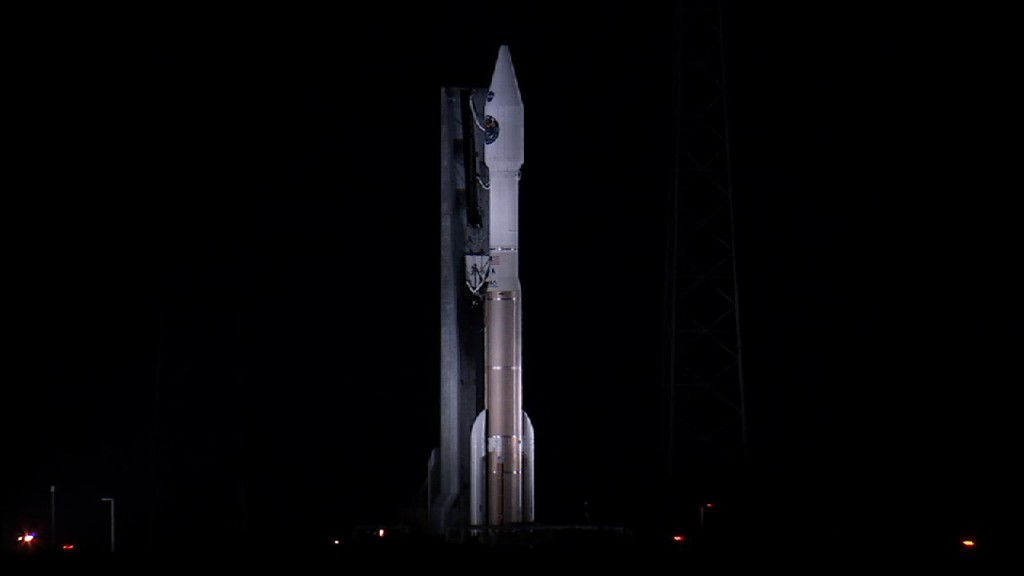NASA Launch Manager Omar Baez of the agency’s Launch Services Program has polled his team of controllers and all have given the go-ahead to move forward with propellant loading.
MMS Countdown Coverage Begins
 Good evening, and thanks for joining us for tonight’s countdown to liftoff of NASA’s Magnetospheric Multiscale mission. The quartet of observatories, labeled MMS-1 through MMS-4, are stacked atop one another and sealed inside the payload fairing on an Atlas V 421 rocket. Launch is slated for 10:44 p.m. EDT from Cape Canaveral Air Force Station’s Launch Complex 41.
Good evening, and thanks for joining us for tonight’s countdown to liftoff of NASA’s Magnetospheric Multiscale mission. The quartet of observatories, labeled MMS-1 through MMS-4, are stacked atop one another and sealed inside the payload fairing on an Atlas V 421 rocket. Launch is slated for 10:44 p.m. EDT from Cape Canaveral Air Force Station’s Launch Complex 41.
Weather is expected to cooperate for tonight’s liftoff. The forecast calls for a 80 percent chance of “go” conditions. The 30-minute launch window provides additional breathing room if necessary.
Launch managers and controllers are stationed at their consoles in the Atlas Spaceflight Operations Center, and the blog comes to you from a console in Hangar AE, which serves as a telemetry and communications hub. Times referenced in the blog are provided in Eastern.
At the moment, countdown clocks are paused at the T-2 hour mark for a 30-minute built-in hold. Activities at the launch pad are on schedule and the next big milestone will be the loading of cryogenic propellants into the Atlas V booster and Centaur upper stage. Managers will poll their respective teams in the next few minutes in order to get those “tanking” operations started at about 8:14 p.m.
Weather Improves to 80 Percent ‘Go’
The U.S. Air Force 45th Weather Squadron has updated its forecast for tonight’s launch to predict an 80 percent chance of favorable weather at 10:44 p.m. EDT, the opening of a 30-minute launch window.
Atlas V 421 to Carry MMS to Orbit

The Atlas V family of rockets comes in several variants depending on the type of payload fairing, number of solid rocket boosters and the number of engines on the Centaur upper stage. MMS will be delivered into orbit by an Atlas V 421, meaning it has a payload fairing measuring four meters (14 feet) in diameter, two solid rocket boosters and a Centaur with a single RL10A engine. With its payload fairing in place, the rocket stands about 195 feet tall.
Propulsion for the Atlas V booster stage is provided by a single RD-180 engine with two thrust chambers. The two solid rocket boosters attach to the first stage and provide additional thrust during the first two minutes of the flight.
This liftoff will be the 53rd for the Atlas V and the fourth flight of this specific variant, the Atlas V 421.
What is Magnetic Reconnection?

Earth is enveloped by a dynamic and complex magnetic field that interacts with charged particles that stream in from space. Our planet’s magnetic field is called the “magnetosphere.” When magnetic field lines are broken and reconfigured, that’s “magnetic reconnection” — and it’s often accompanied by a large explosion of energy.
This process is not unique to Earth. After all, magnetic fields and interactions are found throughout the universe. But closer to home, magnetic reconnection is a major driver of solar activity and space weather events such as solar flares and coronal mass ejections. These violent outbursts can be harmful to astronauts in orbit, and can affect our power grid and disrupt the satellites we use every day for communications, weather forecasting and navigation.
In other words, whether we’re aware of it or not, we’re heavily invested in the goings-on in Earth’s magnetosphere. But magnetic reconnection isn’t well understood just yet. That’s what the MMS mission is all about. NASA is sending four identical spacecraft to fly in formation and observe these events from an unprecedented front-row seat to help us better understand this mysterious process.
Launch Remains ‘Go’; Coverage Begins at 8 p.m. EDT
Activities are on schedule for tonight’s planned liftoff of MMS aboard a United Launch Alliance Atlas V rocket at 10:44 p.m. EDT. Weather remains forecast to be 70 percent favorable during the 30-minute launch window.
Join us for live countdown coverage tonight starting at 8 p.m. EDT. To subscribe to our MMS Blog updates via email, go to https://blogs.nasa.gov/mms/feed.
Also, in case you missed it, a list of local launch viewing locations is available here.
Atlas V Rolls to Launch Pad
 One day before scheduled launch, the United Launch Alliance Atlas V rocket with NASA’s Magnetospheric Multiscale spacecraft onboard rolls out of the Cape Canaveral Air Force Station Space Launch Complex 41 Vertical Integration Facility on route to the launch pad. Launch is scheduled for March 12 and will carry the four identical MMS spacecraft into orbit to provide the first three-dimensional view of magnetic reconnection. Photo Credit: (NASA/Aubrey Gemignani)
One day before scheduled launch, the United Launch Alliance Atlas V rocket with NASA’s Magnetospheric Multiscale spacecraft onboard rolls out of the Cape Canaveral Air Force Station Space Launch Complex 41 Vertical Integration Facility on route to the launch pad. Launch is scheduled for March 12 and will carry the four identical MMS spacecraft into orbit to provide the first three-dimensional view of magnetic reconnection. Photo Credit: (NASA/Aubrey Gemignani)
New Videos Explain MMS Mission, Launch Preps
MMS mission and launch managers explain what the pioneering mission is all about — and what it will take to deliver the four identical MMS spacecraft into the dynamic magnetic system surrounding our planet.
This video provides an overview of what it took to prepare the MMS observatories and the United Launch Alliance Atlas V rocket for launch.
Today is L-1 for Atlas V, MMS
Today’s the day before scheduled launch, or “L-1.” NASA’s MMS spacecraft and the United Launch Alliance Atlas V rocket are slated to lift off Thursday at 10:44 p.m. EDT. The launch weather forecast issued this morning by the U.S. Air Force 45th Weather Squadron continues to predict a 70 percent chance of favorable conditions, with cumulus clouds and thick clouds the primary concerns at launch time.
An array of mission experts will offer an in-depth look at the MMS mission during a science briefing today at NASA’s Kennedy Space Center in Florida. Watch the briefing live on NASA TV beginning at 1 p.m.
If you’re in the central Florida area and would like to watch the launch in person, be sure to check out our list of launch viewing areas around the Space Coast. Sometimes launches are visible from farther away in Florida or along the eastern seaboard, but the view from afar depends on weather and atmospheric conditions.
Launch Weather Forecast Remains Favorable; Prelaunch Briefing Begins
The weather forecast for Thursday night’s launch of NASA’s MMS mission continues to call for 70 percent chance of acceptable conditions at launch time. The concern is for cumulus or thick clouds. The forecast also predicts acceptable weather for Wednesday’s rollout of the United Launch Alliance Atlas V to the launch pad at Space Launch Complex 41 at Cape Canaveral Air Force Station in Florida.
Liftoff remains on schedule for 10:44 p.m. EDT. If there is a one-day scrub, the weather is expected to worsen slightly to a 60 percent chance of acceptable conditions.
A prelaunch news conference originating from NASA’s Kennedy Space Center in Florida is beginning now on NASA TV.

